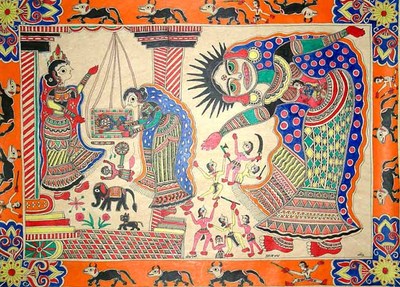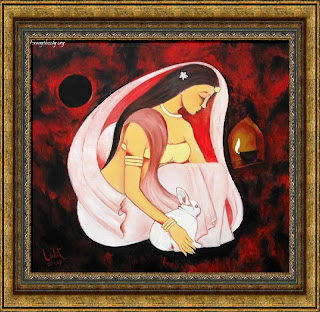Beautiful Indian Art History With images
Indian art evolved with an emphasis on inducing special spiritual or philosophical states in the audience, or with representing them symbolically. According to Kapila Vatsyayan, "Classical Indian architecture, sculpture, painting, literature (kāvya), music, and dancing evolved their own rules conditioned by their respective media, but they shared with one another not only the underlying spiritual beliefs of the Indian religio-philosophic mind, but also the procedures by which the relationships of the symbol and the spiritual states were worked out in detail."
In the Pan Indian philosophic thought the term 'Satyam Shivam Sundaram' is another name for the concept of the Supreme. 'Sat' is the truth value, 'Shiv' is the good value & 'Sundaram' is the beauty value. Man through his 'Srabana' or education, 'Manana' or experience and conceptualization and 'Sadhana' or practice, through different stages of life (Asramas) comes to form and realize the idea of these three values to develop a value system. This Value-system helps us to develop two basic ideas 1) that of 'Daksha' or the adept/expert and 2) of Mahana/Parama or the Absolute and thus to judge anything in this universe in the light of these two measures, known as 'Adarsha'. A person who has mastered great amounts of knowledge of the grammars, rules, & language of an art-form are adepts (Daksha), whereas those who have worked through the whole system and journeyed ahead of these to become a law unto themselves is called a Mahana. Individuals idea of 'Daksha' and 'Mahana' is relative to one's development of the concept of 'Satyam-Shivam-Sundaram.' For example, Tagore's idea of these two concepts should be way above any common man's and many perceive Tagore as a 'Mahana' Artist in the realm of literature. This concept of Satyam-Shivam-Sundaram, a kind of Value Theory is the cornerstone of Indian Aesthetics.
Of particular concern to Indian drama and literature are the term 'Bhava' or the state of mind and rasa referring generally to the emotional flavors/essence crafted into the work by the writer and relished by a 'sensitive spectator' or sahṛdaya or one with positive taste and mind. Poets like Kālidāsa were attentive to rasa, which blossomed into a fully developed aesthetic system. Even in contemporary India the term rasa denoting "flavor" or "essence" is used colloquially to describe the aesthetic experiences in films; "māsala mix" describes popular Hindi cinema films which serve a so called balanced emotional meal for the masses, savored as rasa by these spectators.
Rasa theory blossoms beginning with the Sanskrit text Nātyashāstra (nātya meaning "drama" and shāstra meaning "science of"), a work attributed to Bharata Muni where the Gods declare that drama is the 'Fifth Veda' because it is suitable for the degenerate age as the best form of religious instruction. While the date of composition varies wildly among scholars, ranging from the era of Plato and Aristotle to the seventh century CE. The Nātyashāstra presents the aesthetic concepts of rasas and their associated bhāvas in Chapters Six and Seven respectively, which appear to be independent of the work as a whole. Eight rasas and associated bhāvas are named and their enjoyment is likened to savoring a meal: rasa is the enjoyment of flavors that arise from the proper preparation of ingredients and the quality of ingredients. What rasa actually is, in a theoretical sense, is not discussed and given the Nātyashāstra's pithy wording it is unlikely the exact understanding of the original author(s) will be known.
The theory of the rasas develops significantly with the Kashmiri aesthetician Ãndandavardhana's classic on poetics, the Dhvanyāloka which introduces the ninth rasa, shānta-rasa as a specifically religious feeling of peace (śānta) which arises from its bhāva, weariness of the pleasures of the world. The primary purpose of this text is to refine the literary concept dhvani or poetic suggestion, by arguing for the existence of rasa-dhvani, primarily in forms of Sanskrit including a word, sentence or whole work "suggests" a real-world emotional state or bhāva, but thanks to aesthetic distance, the sensitive spectator relishes the rasa, the aesthetic flavor of tragedy, heroism or romance.
The 9th - 10th century master of the religious system known as "the nondual Shaivism of Kashmir" (or "Kashmir Shaivism") and aesthetician, Abhinavagupta brought rasa theory to its pinnacle in his separate commentaries on the Dhvanyāloka, the Dhvanyāloka-locana (translated by Ingalls, Masson and Patwardhan, 1992) and the Abhinavabharati, his commentary on the Nātyashāstra, portions of which are translated by Gnoli and Masson and Patwardhan. Abhinavagupta offers for the first time a technical definition of rasa which is the universal bliss of the Self or Atman colored by the emotional tone of a drama. Shānta-rasa functions as an equal member of the set of rasas but is simultaneously distinct being the most clear form of aesthetic bliss. Abhinavagupta likens it to the string of a jeweled necklace; while it may not be the most appealing for most people, it is the string that gives form to the necklace, allowing the jewels of the other eight rasas to be relished. Relishing the rasas and particularly shānta-rasa is hinted as being as-good-as but never-equal-to the bliss of Self-realization experienced by yogis.
The earliest Indian paintings were the rock paintings of pre-historic times, the petroglyphs as found in places like Bhimbetka, and some of them are older than 5500 BC. Such works continued and after several millennia, in the 7th century, carved pillars of Ellora, Maharashtra state present a fine example of Indian paintings, and the colors, mostly various shades of red and orange, were derived from minerals. Thereafter, frescoes of Ajanta and Ellora Caves appeared. India’s Buddhist literature is replete with examples of texts which describe that palaces of kings and aristocratic class were embellished with paintings, but they have largely not survived. But, it is believed that some form of art painting was practiced during that time.
Indian paintings provide an aesthetic continuum that extends from the early civilization to the present day. From being essentially religious in purpose in the beginning, Indian painting has evolved over the years to become a fusion of various cultures and traditions. The Indian painting was exposed to Greco-Roman as well as Iranian and Chinese influences. Cave paintings in different parts of India bear testimony to these influences and a continuous evolution of new idioms is evident.

























0 comments:
Post a Comment